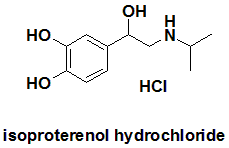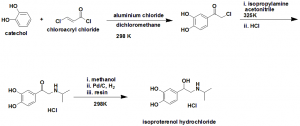ISOPROTERENOL Synthesis, SAR, MCQ,Structure,Chemical Properties and Therapeutic Uses
Isoproterenol
IUPAC nomenclature
(RS)-4-[1-hydroxy-2-(isopropylamino)ethyl]benzene-1,2-diol

Classification
Isoproterenol is ß2-adrenergic agonist. [1]
Physiochemical Properties
| S. NO. | PHYSICAL AND CHEMICAL PROPERTIES | |
| 1 | Molecular weight | 211.26 g/mol |
| 2 | Physical appearance | Present in solid form |
| 3 | Melting point | 170.5°C |
| 4 | Solubility | 50mg/ml at r.t. in water. |
| 5 | Octanol/water partition coefficient | 1.4 |
| 6 | Presence of ring | Benzene ring present |
| 7 | Number of chiral centers | 1 |
Mechanism of Action
i. Adenyl cyclase enzyme is stimulated through the ß-adrenergic receptors.
ii. The conversion of ATP to cyclic AMP also increases due to this.
iii. Due to raise in level of cAMP, relaxation of bronchial smooth muscles and inhibition of release mediators of immediate hypersensitivity from mast cells takes place.
Structure Activity Relationship
- Primary or secondary aliphatic amine separated by two carbons from a substituted benzene ring is essential for the high agonist activity.
- The hydroxyl substituted carbon must be in the R configuration for the maximal direct activity.
R1 substitution:
- When R1 is increased in size, activity of alpha receptors decreases and activity of the beta receptors increases
- Activity of both alpha and beta receptors is maximum when R1 is methyl group.
- Alpha agonist activity decreases when R1 is larger than methyl, and went negligible when R1 is isopropyl.
- Large lipophillic groups can afford compounds with alpha blocking activity.
- N-substituent provides selectivity for different receptors.
- Arylalkyl group can provide beta selectivity, increased cell penetration and increased lipophillicity for the longer duration of action.
R2 substitution:
- Ethyl group can eliminate the alpha activity of the drug.
- Erythrostero isomers have maximal activity.
- The additional methyl group makes the drug more selective for the alpha2
R3 substitution on the aromatic ring:
- 3’,4’-dihydroxy substituted benzene ring has poor oral activity.
- 3’, 5’-dihydroxy compounds are orally active.
- At least one of the groups is required which can form hydrogen bonds. And if only one group is present then it is preferred at 4’ position to retain the beta2
- If phenyl group has no phenolic substituent then it may act directly or indirectly.[2]
Method of synthesis
i. Catechol reacts with chloroacetyl chloride in presence of Aluminium chloride and dichloromethane to give 2-chloro-3’,4’-dihydroxyacetophenone.
ii. Latter compound is reacted with isopropylamine followed by reaction with HCl to give 3’,4’-dihydroxy 2-(isopropylamino) acetophenone hydrochloride.
iii. It was then hydrogenated in presence of palladium catalyst and a resin, in an alcoholic solvent. Resin such as amberlite IRA-904 can be used to produce isoproterenol.

Therapeutic Uses
The drug used for the treatment of:
- Heart blocks
- Adams-Stokes syndrome
- Ventricular tachycardia
- Ventricular fibrillations
- Cardiac arrests
- Bronchospasms
- Adjunct in the treatment of hypovolemic shock, septic shock
- Hypofusion states
- Congestive heart failures
- Asthma
Side Effects
Common side effects of isoproterenol are
- nervousness,
- pailor,
- flushing,
- weakness,
- mild tremors,
- sweating,
- difficulty in breathing,
- arrhythmias,
- hypotension,
- hypertension,
- pulmonary edema,
- angina,
- palpitations,
- tachycardia,
- visual blurring,
- nausea,
- dizziness and headaches.
Less common side effect include insulin resistance leading to diabetic ketoacidosis.
MCQs
Q.1 Due to action of isoproterenol-
a) CAMP level increases
b) ATP level increases
c) Contraction of bronchial smooth muscles takes place
d) Both a) and c)
Q.2 Therapeutic use of drug isoproterenol is/are?
a) Bronchospasm
b) Asthma
c) Congestive heart failure
d) All of the above
Q.3 Which amongst the following are the incorrect statements with respect to the SAR of drug Isoproterenol
I. The hydroxyl substituted carbon must be in the R configuration for the maximal direct activity.
II. Large lipophillic groups at R 1 can afford compounds with alpha blocking activity
III. Ethyl group at R2 can eliminate the alpha activity of the drug.
a) I
b) II,III
c) I, III
d) None
Q.4 The starting chemicals required for the synthesis of drug isoproterenol?
a) Catechol
b) Chloroacetyl chloride
c) Aluminium chloride
d) All of the above
Q.5 Correct sequence for the True/False for the physiochemical properties of the drug Isoproterenol?
I. Molecular weight is 211.26 g/mol
II. It is present in solid form at room temperature
III. Melting point is 170.5°C
IV. No chiral carbon is present in the structure
a) TTTF
b) FFTF
c) TFTF
d)FTFT
Q.6 Correct statements for the IUPAC nomenclatures of the drugs are?
I. Isoproterenol: (RS)-4-[1-hydroxy-2-(isopropylamino)ethyl]benzene-1,2-diol
II. Dopamine: 4-(2-Aminoethyl)benzene-1,2-diol
III. Oximetazoline: (R)-3-[-1-hydroxy-2-(methylamino)ethyl]phenol
IV. Phenylephrine: 3-(4,5-Dihydro-1H-imidazol-2-ylmethyl)-2,4-dimethyl-6-tert-butyl-phenol
a) I, II
b) III, II
c) I, III, IV
d) III, IV
Q.7 Match the following drugs with their correct classifications-
| i. Isoproterenol | A. Mixed-acting sympathomimetics |
| ii. Amphetamine | B.ß2-adrenergic agonist |
| iii. Epinephrine | C. Nonselective α-adrenergic antagonist |
| iv. Tolazine | D. Nonselective adrenergic agonist |
a) i-B, ii-C, iii-D, iv-A
b) i-A, iiD-, iii-C, iv-B
c) i-B, ii-A, iii-D, iv-C
d) i-B, ii-C, iii-A, iv-D
ANSWERS
1-a
2-d
3-d
4-d
5-a
6-a
7-c
REFERENCES
[1] Lemke TL, Zito SW, Roche VF, Williams DA. Essentials of Foye’s principles of medicinal chemistry. Wolters Kluwer; 2017, 340 [2] Lemke TL, Zito SW, Roche VF, Williams DA. Essentials of Foye’s principles of medicinal chemistry. Wolters Kluwer; 2017, 348-352